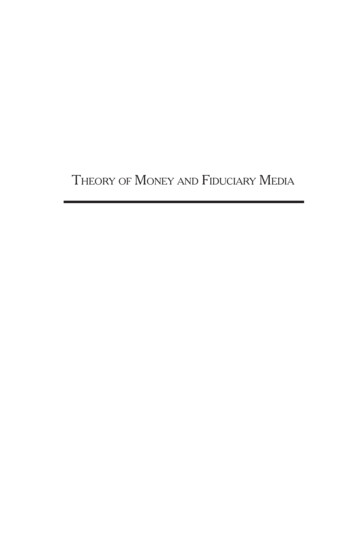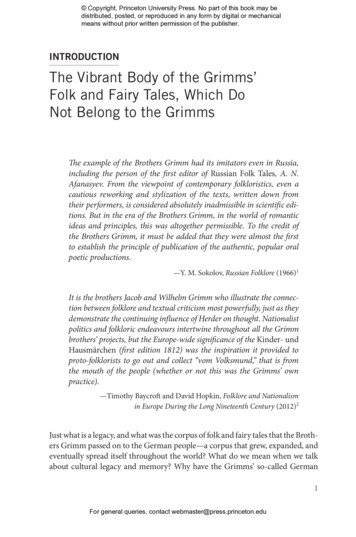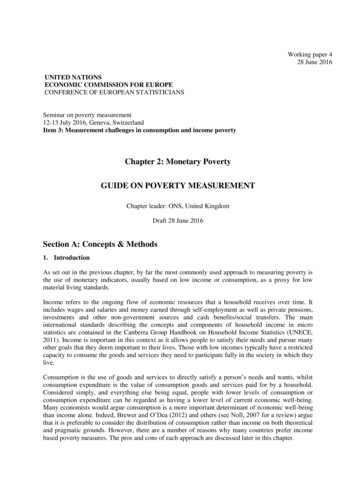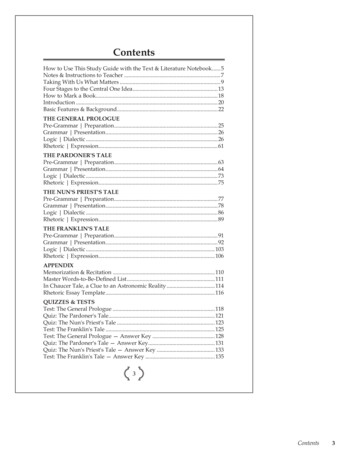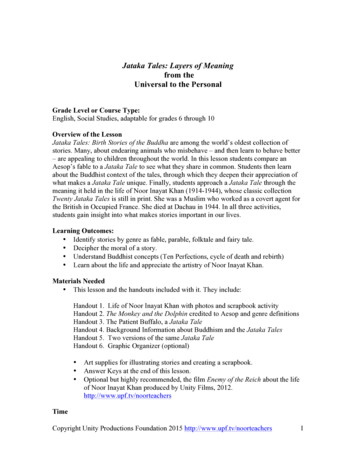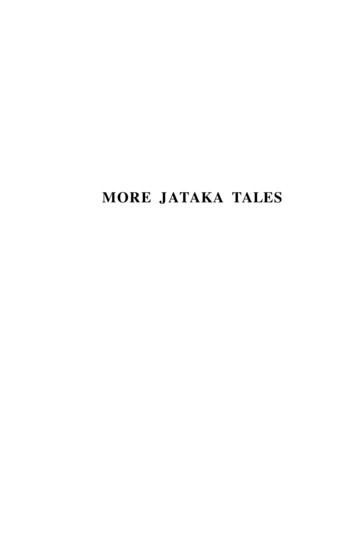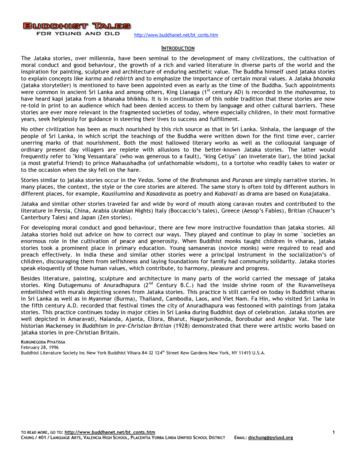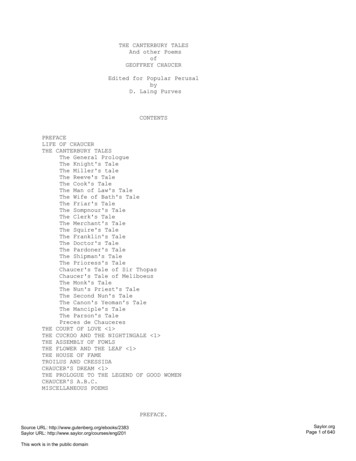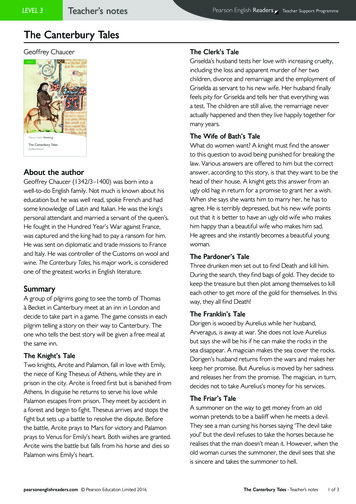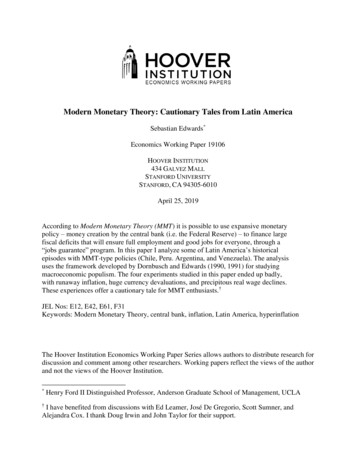
Transcription
Modern Monetary Theory: Cautionary Tales from Latin AmericaSebastian Edwards*Economics Working Paper 19106HOOVER INSTITUTION434 GALVEZ MALLSTANFORD UNIVERSITYSTANFORD, CA 94305-6010April 25, 2019According to Modern Monetary Theory (MMT) it is possible to use expansive monetarypolicy – money creation by the central bank (i.e. the Federal Reserve) – to finance largefiscal deficits that will ensure full employment and good jobs for everyone, through a“jobs guarantee” program. In this paper I analyze some of Latin America’s historicalepisodes with MMT-type policies (Chile, Peru. Argentina, and Venezuela). The analysisuses the framework developed by Dornbusch and Edwards (1990, 1991) for studyingmacroeconomic populism. The four experiments studied in this paper ended up badly,with runaway inflation, huge currency devaluations, and precipitous real wage declines.These experiences offer a cautionary tale for MMT enthusiasts.†JEL Nos: E12, E42, E61, F31Keywords: Modern Monetary Theory, central bank, inflation, Latin America, hyperinflationThe Hoover Institution Economics Working Paper Series allows authors to distribute research fordiscussion and comment among other researchers. Working papers reflect the views of the authorand not the views of the Hoover Institution.*†Henry Ford II Distinguished Professor, Anderson Graduate School of Management, UCLAI have benefited from discussions with Ed Leamer, José De Gregorio, Scott Sumner, andAlejandra Cox. I thank Doug Irwin and John Taylor for their support.
11. IntroductionDuring the last few years an apparently new and revolutionary idea has emerged in economicpolicy circles in the United States: Modern Monetary Theory (MMT). The central tenet of thisview is that it is possible to use expansive monetary policy – money creation by the central bank(i.e. the Federal Reserve) – to finance large fiscal deficits, and create a “jobs guarantee” programthat will ensure full employment and good jobs for everyone. 1 This view is related to AbbaLerner’s (1943) “functional finance” idea, and has become very popular in progressive spheresand among some candidates running in the Democratic Party primary. According to MMTsupporters, this policy would not result in crowding out of private investment, nor would itgenerate inflation outbursts. 2MMT runs against received wisdom among economists, and has been resisted by Keynesians andmonetarists alike. Respected and influential academics such as Paul Krugman, Kenneth Rogoff,and Larry Summers, among others, have stated that MMT makes little sense. Krugman haswritten that the principles behind MMT are “indefensible,” and that the arguments made by itssupporters are “sophistry.”3 According to Rogoff, MMT is “nonsense” based “on somefundamental misconceptions.”4 And Summers has contended that embracing “modern monetarytheory is a recipe for disaster.”5MMT supporters have responded by saying that their critics don’t truly understand how modernmonetary economies work. According to them, in countries with a currency of their own,governments don’t face a hard budget constraint; the government can always print additionalmoney to pay for higher expenditures.6 Since central banks have the monopoly power to issuemoney, doing so has no cost in terms of real resources. According to Stephanie Kelton (2019)“the government budget is not like a household budget because the government prints its ownmoney.”7 Along similar lines, Forstater and Mosler (2005) have argued that in a “fiat money”1See Wray (2015) for details. The term “Modern” is supposed to be an inside joke, and refers to a statement madeby Keynes in page 4 of “A Treatise on Money” (1930), where he says that for at least four thousand years moneyhas been the creation of the State. Money is whatever the State accepts in payment of taxes. See Knapp (1904).2See, for example, Forstater and Mosler (2005), Tymoigne and Wray (2013, 2015), and Wray (2013) and theliterature cited therein. Scott Sumner has discussed MMT in depth in his blog. See Sumner and Horan 01ffb5bd5e6 story.html?utm term .a6e4c2bbafc16MMT has also been called “Neo‐Chartalism.” The term Chartalism was introduced by German economist G.F.Knapp in 1905 to refer to a theory where the value of money is not tied to the value of a commodity, such as gold.It is interesting to notice that Schumpeter (1954, p. 288) spelled the term as ‐deficit‐1536853788. Emphasisadded.
2system the natural rate of interest is zero; the role of the monetary authority is to push the actualrate to zero, through the purchase of government securities. If long term equilibrium interestrates are equal to zero, then, 𝑟𝑔 in growing economies, and there would be no explosion of8government debt.MMT supporters have argued that in order for these policies to work, the country in questiondoes not need to have a “convertible currency”; all is needed is sovereign fiat money thateconomic agents have to use to pay taxes. Thus, even though it could be somewhat less effectivethan in advanced nations, MMT would still work in emerging countries, including in many of thenations of Asia and Latin America.9Efforts to evaluate the merits of MMT have run into two types of difficulties: First, there is nounified description of how the MMT model is supposed to work. This is not due to a lack ofpublications. In fact, MMTers are prolific authors, and have published a large number of papers,pamphlets and books, including some primers. However, these works contain very few (if any)equations or diagrams; MMT authors have generally avoided the language that, for better or forworse, has become dominant in scholarly conversations among professional economists.10 Bydoing this, MMTers have left themselves open to the criticism that their models lack clarity. Forexample, Paul Krugman (2019) recently wrote that MMT supporters “tend to be unclear aboutwhat exactly their differences with conventional views are, and also have a strong habit ofdismissing out of hand any attempt to make sense of what they’re saying.”11A second difficulty in evaluating MMT is that its supporters have offered very little empiricalevidence on how the policy would function, especially in the medium and longer run.12 Althoughsome authors have argued that Japan during the last decade or so provides evidence that theapproach works, most critics – including the Governor of the Bank of Japan, Haruhiko Kuroda –disagree with that contention.13 When discussing the applicability of MMT to the United States,Neil Irwin (2019) has argued that it would be interesting to have the policies implemented in a8For a skeptical view see, for instance, Sumner and Horan (2019).Wray (2015, pp. 124‐129).10See, for example, Forstater and Mosler (2005), Tymoigne and Wray (2013), and Wray (2015, 2018) and theliterature cited onkish.html. Emphasisadded.12There seems to be agreement that in the short run, and under especial circumstances, such a severe crisis similarto the one triggered by the subprime mortgages collapse, a short run policy based on massive purchases ofgovernment paper by the Central bank would make ove‐modern‐monetary‐theory‐a‐mistake9
3small country first, as an experiment. He titled his piece “How About We Try Modern MonetaryTheory in a Small Country First?” He wrote:14“It would be nice to have some proof of concept before it is put in place in thelargest economy in the world — also home to the world’s reserve currency Itwould be genuinely fascinating to watch a small country — with its own currency— govern itself according to the [MMT] theory’s principles. If those smallercountries can work out the kinks of economic governance in an MMT world, andachieve a higher standard of living, maybe then scale it up to a midsize country?”It turns out that MMT – or some version of it – has been tried in the past in a number ofemerging countries. Although most cases have taken place in Latin America, there have alsobeen episodes in other parts of the world, including in Turkey and Israel. MMT-type policieswere also attempted briefly in France during the Mitterrand presidency. Almost every one of theLatin American experiments with major central bank-financed fiscal expansions took placeunder populist regimes, and all of them ended up badly, with runaway inflation, huge currencydevaluations, and precipitous real wage declines. In most of these episodes – Chile, Argentina,Brazil, Nicaragua, Peru, Venezuela – policy makers used arguments similar to those made byMMTers to justify extensive use of money creation to finance very large increases in publicexpenditures.In this paper I analyze some of Latin America’s episodes with MMT-related policies, and I showthat all these cases ended up in major macroeconomic disasters. The analysis uses the frameworkdeveloped by Dornbusch and Edwards (1990, 1991) for studying macroeconomic populism.The rest of the paper is organized as follows: In Section 2 I present the basic principles of LatinAmerican populism, and compare them to some of the views of MMTers. I argue that most LatinAmerican populist experiences go through four phases: they begin well, and usually generate ashort term increase in output, employment and wages. However, macroeconomic imbalances andinflationary pressures eventually appear, and enthusiasm turns into concern. Ultimately, there isa major crisis. In Section 3 I analyze four specific Latin American episodes with major centralbank-financed fiscal expansions: Chile during President Salvador Allende’s socialist experiment(1970-1973); Peru during the first Alan Garcia presidency (1985-1990); Argentina during boththe Kitchener and Fernandez presidencies (2003-2015); and Venezuela, under Hugo Chávez andRafael Maduro (1998-now). The most important point made in this section is that in all of theseepisodes’ policies similar to those espoused by MMTers were implemented. I show that at theend of these episodes’ real wages were significantly lower that at the beginning. These are html
4“cautionary tales” referred to in the title of this paper. Finally, in Section 4 I provide someconcluding remarks.2. Latin American Populism2.1 The mechanics of Latin American populism and MMTMacroeconomic populism is usually defined as a set of policies aimed at redistributing incomeby running high fiscal deficits, financed (mostly) through an expansive monetary policy.15 Inevery Latin American experience with populist policies the government granted wage increases –both public sector and minimum wages – that exceeded significantly what was justified byimprovements in productivity. Just as MMTers, populist politicians present heterodoxy as thesolution to the nation’s ills, and in particular to the suffering of the middle and lower classes. 16For populists, one of the features of capitalist economies is the existence of substantial idlecapacity. Thus, in their view, large and persistent fiscal deficits do not result in seriousimbalances, high inflation, and, eventually, in crises. For populists the contrary is true: largefiscal deficits expand demand and encourage production, allowing firms to exploit economies ofscale and to use resources fully. For them the combination of large deficits with redistributivepolicies result in a decline in inflation. Moreover, for populists, as for MMTers, the mostefficient and effective way of financing the fiscal deficit is through money creation by the centralbank.17 Populists tend to dismiss possible collapses in the demand for domestic money, andincreases in the velocity of circulation.These views are clearly captured by the following quote from Daniel Carbonetto (1987, p.82),the economist behind Alan Garcia’s populist policies in Peru in the second half of the 1980s: “Ifit were necessary to summarize the strategy adopted by the government since August 1985 withtwo words, they are control (meaning control of prices and costs) and spend, transferringresources to the poor so that they increase consumption ” Carbonetto then added that budgetconstraints had to be ignored:15See Dornbusch and Edwards (1990, 1991). Edwin Williamson (1992, p. 347), defined populism as “thephenomenon where a politician tries to win power by courting mass popularity with sweeping promises of benefitand concessions to the lower classes.” Political scientist Michael L. Conniff (1982, p. 82) pointed out that “populistprograms frequently overlapped with those of socialism.” More recently, Acemoglu, Egorov, and Sonin (2012, p.771) stated that populist “politicians use a rhetoric that aggressively defends the interests of the common managainst the privileged elite.” Eichengreen (2018, p.1) wrote that populism is a “political movement with anti‐elite,authoritarian, and nativist tendencies.” Parts of this section draw on Edwards (2019).16In Dornbusch and Edwards (1991), case studies for Argentina, Chile, Peru, Colombia, Brazil, and Nicaragua arepresented.17See Chapter 8 in Edwards (2010).
5“It is necessary to spend, even at the cost of a large fiscal deficit, because, whenthis deficit transfers public resources to increase consumption of the poorest, theydemand more goods and this will bring about a reduction in unit costs. Thus thedeficit is not inflationary.”This statement, is very similar to what Stephanie Kelton, one of the most prominent supportersof MMT stated in 2019: “the government budget is not like a household budget because thegovernment prints its own money.”18 It is also similar to what Wray (2015, p. 104) writes in hisprimer on MMT: “The following statements do not apply to a sovereign currency issuinggovernment Governments have a budget constraint [g]overnment deficits drive interestrates up, crowd out the private sector and lead to inflation.”In addition to rejecting fiscal balance and sound monetary policy, Latin American populistsreject markets, competition, and globalization. They believe in price and exchange controls, highminimum wages, high import tariffs, and large subsidies, mostly for food and publictransportation. They support state-owned-enterprises, and they favor nationalizing largemultinationals (often associated to natural resources, such as oil and mining). In some instances,Latin American populists have borrowed from Marxist ideology, as was the case with HugoChavez’s “Socialism of the 21 century” program.19But, it would be a mistake to believe that populists “like” or “favor” inflation. They don’t. Infact, before taking power, populist politicians usually declare that one of their fundamentalobjectives is to reduce or eliminate inflation. They state that price increases benefit large firms,and hurt the working class. For instance, in Chile, the Unidad Popular electoral platform of 1970stated that a main goal of the “popular government” was to achieve “price stability.”20 Inrepeated speeches President Salvador Allende pointed out that price controls would play a keyrole in defeating inflation.21 For President Salvador Allende the fact that the quantity of moneyincreased by 124% during his first year in office was not a problem; on the contrary, for Allendemonetary expansion played a key role in helping finance Chile’s move towards Socialism.22MMT supporters also assert that one of their main goals is to achieve stability. According toWray (2015, p. 244) “MMTers fear inflation, too. Indeed, price stability has always been one ofthe two key missions of [the MMT �deficit‐1536853788. Emphasisadded.19Many of their views are associated with the traditional “structuralism approach” to economic development,espoused by thinkers such as Raul .htm#0521Interestingly, Abba Lerner, an inspirations for Matters, argued that the most efficient way to deal withinflationary pressures was the use of price controls.22See the various speeches on the economy in Allende (1989).
6In the vast majority of Latin American populist episodes, the populist leader came to power aftera major crisis. In many cases, the IMF had been called to bring order into the economy. In everycase, the IMF imposed an “austerity-based” adjustment program, which exacerbated the sense offrustration among the country’s citizens, and in particular among the middle and lower classes.Although a structurally unequal distribution of income is not a requirement for the emergence ofpopulism, populist rhetoric is more attractive in countries with significant income disparities, orin countries were inequality has raised during the immediate past.23The importance of initial conditions in the emergence of populist regimes is illustrated clearly insome of the most salient populist experiences in Latin America. For example, in Argentina, theadministration of President Nestor Kirchner came to power after the major currency and bankingcrisis of 2001-02, when the currency board collapsed. As a result of this crisis unemploymentskyrocketed above 25%, and the peso lost almost 80% of its value in three years. In Venezuela,the populist policies of Hugo Chávez (later continued by Nicolas Maduro) were put in place aftera succession of economic and political crises. The initial event that gave impetus to the populistmovement took place almost ten years before the accession of Hugo Chávez to power. OnFebruary 27 1989, and as a result of an announced 30% increase in public transportation fares,riots erupted in Caracas.24 The military were called in to reestablish order. After five days ofviolence, more than 300 people had been killed. This crisis – the episode is known as the“Caracazo” – set the stage for Colonel Hugo Chavez attempted coup in February of 1992, and tohis eventual election as President in 1998, when he won the election by a landslide, trouncing hisopponent by more than 16 percentage points. (Hausmann and Rodriguez 2016).2.2 The four phases of Latin American populismMost macroeconomic populist experiments go through four distinct phases that span fromeuphoria to collapse. The length of the cycle depends on a number of factors, including theevolution of the terms of trade, political institutions, the availability of foreign financing byfriendly nations, and the degree of political repression.25During Phase 1, stimuli to aggregate demand are met by increased capacity utilization andhigher imports. It is during this phase that policies very similar to those espoused by MMT arefirst put in place. Government expenditures increase rapidly, and massive income transfers areimplemented. Public sector wages and minimum wages are raised, and large public sectorinvestment projects enacted. These policies are financed by a combination of easy money thatflows from the central bank, increases in government debt, and foreign resources that come from23Edwards (2010), Chapter 8.The increase in transportation fares was a component of an IMF program.25A formal model that captures these cycles is presented in Dornbusch and Edwards (1990). Acemoglu et al (2012)develop a more general model that generates this type of populist dynamics.24
7the country’s international reserves. In some cases, such as Peru in the mid-1980s and Argentinain the early 2000s, the restructuring of international debt provides some additional financingspace.26 Some foreign financing may also come from friendly countries. During this early phasethe populist views are vindicated, or so it seems. Prices are held more or less in line throughincreased imports, the depletion of inventories, and, some kind of price guidance and controls.The population is happy, as incomes and wages go up, and the populist leader repeatedly makesthe point that orthodox economics and its supporters are wrong. In some cases –Argentina duringthe early 2000s, and Venezuela under Chávez are good examples –, an improvement in the termsof trade provides additional financing.During Phase 2 the consequences of the heterodox policies begin to show up, and bottlenecksand imbalances emerge. International reserves become dangerously low, foreign exchangebecomes scarce and there are significant forces for the currency to depreciate rapidly. Exchangecontrols are introduced – France under Mitterrand, in 1984, is a good example from outside ofLatin America. In some cases, such as Argentina during President Fernandez, traditional exportsare taxed. In spite of these measures, prices continue to rise. The populist response is to decreegeneralized price controls (price controls are considered by MMTers an integral part of thepolicy kit; Wray 2015, Chapter 8.1). Unions ask for higher salaries, and indexation practices areadopted. The central bank continues to lend vast amounts to the public sector, helping maintainthe experiment alive. The economy enters into an inflationary spiral. A black market fornecessities, including food, develops and a parallel market for foreign exchange appears.Phase 3 is characterized by a deepening of imbalances and a worsening of economic conditions.Inflation accelerates, generally moving to the three or four digits’ terrain. Fiscal dominancebecomes more acute, as the central bank continues to finance the government. The frequency ofprice adjustments through indexation increases, first to quarterly and then to monthly intervals.Pervasive indexation tends to worsen the fiscal accounts through the so-called “Olivera-Tanzieffect.” Government expenditures increase according to the indexing formula, while tax revenuesare collected based on lagged income and profit figures. Consumers ditch the domestic currency,and foreign exchange becomes the medium of exchange. However, since the governmentrequires that taxes are paid in domestic currency, the local monies (pesos, soles, escudos,bolívares, córdobas) do not disappear completely. Demand, however, falls very rapidly, withvelocity of circulation increasing significantly. The disparity between inflation (very high) andexchange rates (depreciating more slowly) intensifies the extent of real exchange rateovervaluation.2726Peru is one of the very few countries that have ever defaulted on the IMF.In some cases, such as Venezuela under Nicolas Maduro, economic conditions become so bleak that thepopulation becomes undernourished and outmigration increases significantly. Rodriguez (2008).27
8During Phase 4 the populist regime is finally replaced. Historically, in Latin America it wasquite common that the end of the populist regime happened through a coup d’état. More recently,however, this has not been the case. Be it as it may, the new post-populism government faces avery fragile economy and frequently a mess. Inflation is usually (very) high, internationalreserves are non-existing, exports are at an all-time low, the government debt is in default, andthe real economy is replete with distortions. When the new government comes into power, realincomes and wages are often below what they were at the beginning of the experiment.3. Four populist episodes in Latin America: Lessons for MMT supportersIn this Section I analyze four of Latin America’s best known populist episodes: Chile duringPresident Salvador Allende’s socialist experiment from 1970 through 1973; Peru during the firstAlan Garcia administration (1985-1990); Argentina during the administrations of PresidentsNestor Kirchner and Cristina Fernandez de Kirchner (2003-2015); and Venezuela during thePresidents Hugo Chavez and Nicolas Maduro governments (1998-now). Although each of thesecases is unique and full of complexities, the four of them share the populist pattern discussedabove. The case of Chile, is possibly the most dramatic one, as the experiment with populistsocialist policies of President Salvador Allende ended up in a violent coup which was followedby a 17-year dictatorship. In both Peru and Venezuela, the central bank-financed fiscalexpansions ended up in hyperinflation. In Peru the rate of inflation peaked at almost 8,000%, andthe International Monetary Fund has forecasted that inflation in Venezuela will be almost onemillion% in 2019. As noted above, the Argentine populist experiments of 2003 was triggered bythe precipitous failure of a currency board experiment which lasted 10 years. Between 1991 and2001 the peso was strictly pegged to the dollar at a one-peso-one-dollar exchange rate. Thecollapse of that particular attempt to fix the exchange rate resulted in a major jump inunemployment, and significant political upheaval, including the resignation of PresidentFernando de la Rua.28 As noted, Venezuela’s episode had its roots in the deteriorating social andeconomic conditions since the Caracas riots of 1992.29The four countries studied in this Section had a sovereign currency, and thus could (and did)follow the type of policies recommended by MMT economists. In addition, these nations satisfyanother requirement for MMT: in all cases the exchange rate was not strictly fixed; the price offoreign currency was adjusted frequently (in some cases daily) through a crawling rate regime or28A number of papers have been written on these cases. The following is a short list of works. Each of themcontains a detailed bibliography on these cases. On Chile see Larrain and Meller (1991), on Peru see Lago (1991),on Argentina and Venezuela see Edwards; on Venezuela, Haussmann and Rodriguez (2014); on Argentina,Bluestein (2006).29In Edwards (2010) I discuss Chile, Argentina and Venezuela. For Peru see Dornbusch and Edwards (1990) andLago (1991). For Chile, see also Edwards and Edwards (1991).
9a “dirty float” system.30 In every one of the episodes exchange controls of one type or anotherwere eventually put in place in an effort to slow down currency depreciation.31I begin the discussion by presenting data on economic growth, and documenting the transitionfrom euphoria to distress. I then discuss the expansion of fiscal policy financed by central bankmoney creation, and the resulting inflation outbursts. The Section ends with an analysis of theevolution of social conditions. I show that in three of the four cases, when the populist regimewas replaced, real wages were lower than when the populist leader took over.3.1 Growth and populism phasesIn Figures 1-A through 1-D I present data on GDP growth for the four episodes. There are two(red) vertical lines in these graphs. The first one corresponds to the initial year of the populistepisode; the second red line refers to the first year of the post-populist regime. The similaritiesacross cases are quite remarkable; the different phases of populist experiments are easy to detectin each one of these Figures. 30In the four episodes it is possible to see that the initial conditions are characterized byeither very low or negative growth. As noted, these depressed circumstances give thepopulist leader the opportunity to present his/her nationalistic, anti-globalization and antielite program, and to get to power. In Chile, growth in 1970 was 2.0%, which meant thatper capita growth was zero.32 In Peru and Argentina, there were IMF programs at thetime García and Kirchner took over the respective governments. In both cases growthwas negative, and in both cases the populist rhetoric criticized the Fund as an institutionthat spreads poverty through the developing world. In Peru, economic conditions werealso negatively affected by the El Niño climatic phenomenon, which resulted in some ofthe worst flooding in the country’s history.33 In Venezuela, growth was negative the yearChávez won the elections. Depressed initial conditions in Venezuela were the result of asuccession of failed adjustment programs – some supported by the IMF–, and a decline inWray (2015) has stated that MMT policies work better if the central bank does not make a firm commitment toexchanging the sovereign money into a commodity (gold) or another currency.31For a list of requirements for MMT to work, see Wray (2015).32As will be seen below in 1970 inflation in Chile was a very high 35%. This was an important component of thesense of crisis in the country. In fact, as mentioned earlier, achieving price stability was one of President Allende’smore important goals. See Edwards and Edwards (1991).33Alan García became President in July 1985. During 1984 Peru had signed an IMF program, for 104 million SDRs.Peru stopped making payments to the IMF in 1987. Argentina entered into IMF programs in 2000 and 2001. OnArgentina, see, Bluestein (2005). Venezuela obtained IMF support in 1996 (300 million SDR), under the presidencyof Rafael Caldera, Hugo Chavez’s predecessor. As in the cases of Peru and Argentina, this program called for fiscalausterity, cutting subsidies, and currency devaluation.
10the price of oil. Memories of the repression and deaths during the Caracazo alsocontributed to the support for Chavez and his program.34 As may be seen from these Figures, Phase 1, with its booming growth, follows thelaunching of the populist programs. In Chile the economy grew at an impressive 9%during the first year of President Salvador Allende’s Unidad Popular government. Perusaw its GDP growth jump to 12% in 1986, one year after Alan García’s election. InArgentina and Venezuela there was also important GDP recovery after the accession topower of the new leaders. In these two countries it
Modern Monetary Theory: Cautionary Tales from Latin America Sebastian Edwards* Economics Working Paper 19106 HOOVER INSTITUTION 434 GALVEZ MALL STANFORD UNIVERSITY STANFORD, CA 94305-6010 April 25, 2019 According to Modern Monetary Theory (MMT) it is possible to use expansive monetary policy - money creation by the central bank (i.e. the Federal Reserve) - to finance large
